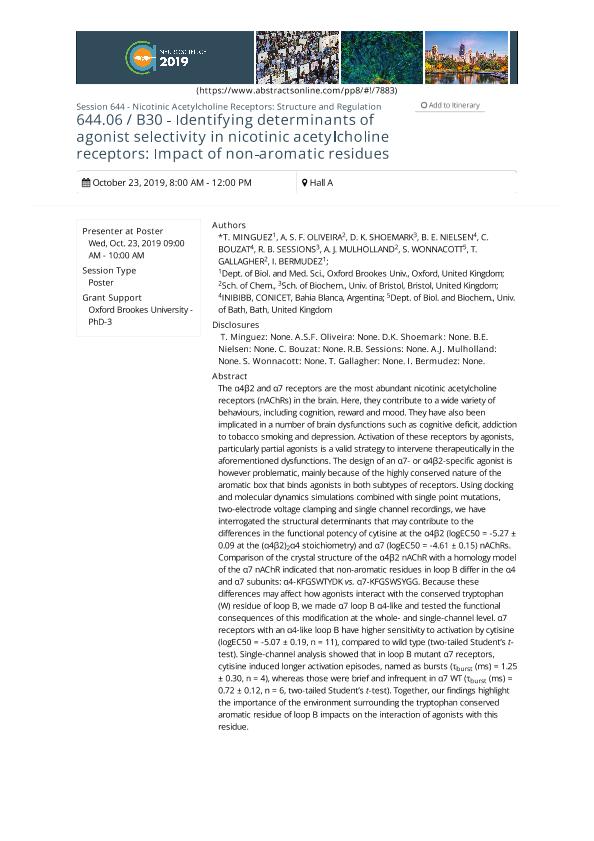Evento
Identifying determinants of agonist selectivity in nicotinic acetylcholine receptors: Impact of non-aromatic residues
Minguez, Teresa; Oliveria, Sofia; Shoemark, D. K.; Nielsen, Beatriz Elizabeth ; Bouzat, Cecilia Beatriz
; Bouzat, Cecilia Beatriz ; Sessions, R. B.; Mullholand, Adrian; Wonnacott, Susan; Gallagher, Timothy; Bermudez, Isabel
; Sessions, R. B.; Mullholand, Adrian; Wonnacott, Susan; Gallagher, Timothy; Bermudez, Isabel
 ; Bouzat, Cecilia Beatriz
; Bouzat, Cecilia Beatriz ; Sessions, R. B.; Mullholand, Adrian; Wonnacott, Susan; Gallagher, Timothy; Bermudez, Isabel
; Sessions, R. B.; Mullholand, Adrian; Wonnacott, Susan; Gallagher, Timothy; Bermudez, Isabel
Tipo del evento:
Congreso
Nombre del evento:
Neuroscience Meeting 2019 of the Society for Neuroscience
Fecha del evento:
19/10/2019
Institución Organizadora:
Society for Neuroscience;
Título del Libro:
2019 Neuroscience Meeting Planner
Editorial:
Society for Neuroscience
Idioma:
Inglés
Clasificación temática:
Resumen
The α4β2 and α7 receptors are the most abundant nicotinic acetylcholine receptors (nAChRs) in the brain. Here, they contribute to a wide variety of behaviours, including cognition, reward and mood. They have also been implicated in a number of brain dysfunctions such as cognitive deficit, addiction to tobacco smoking and depression. Activation of these receptors by agonists, particularly partial agonists is a valid strategy to intervene therapeutically in the aforementioned dysfunctions. The design of an α7- or α4β2-specific agonist is however problematic, mainly because of the highly conserved nature of the aromatic box that binds agonists in both subtypes of receptors. Using docking and molecular dynamics simulations combined with single point mutations, two-electrode voltage clamping and single channel recordings, we have interrogated the structural determinants that may contribute to the differences in the functional potency of cytisine at the α4β2 (logEC50 = -5.27 ± 0.09 at the (α4β2)2α4 stoichiometry) and α7 (logEC50 = -4.61 ± 0.15) nAChRs. Comparison of the crystal structure of the α4β2 nAChR with a homology model of the α7 nAChR indicated that non-aromatic residues in loop B differ in the α4 and α7 subunits: α4-KFGSWTYDK vs. α7-KFGSWSYGG. Because these differences may affect how agonists interact with the conserved tryptophan (W) residue of loop B, we made α7 loop B α4-like and tested the functional consequences of this modification at the whole- and single-channel level. α7 receptors with an α4-like loop B have higher sensitivity to activation by cytisine (logEC50 = -5.07 ± 0.19, n = 11), compared to wild type (two-tailed Student’s t-test). Single-channel analysis showed that in loop B mutant α7 receptors, cytisine induced longer activation episodes, named as bursts (τburst (ms) = 1.25 ± 0.30, n = 4), whereas those were brief and infrequent in α7 WT (τburst (ms) = 0.72 ± 0.12, n = 6, two-tailed Student’s t-test). Together, our findings highlight the importance of the environment surrounding the tryptophan conserved aromatic residue of loop B impacts on the interaction of agonists with this residue.
Palabras clave:
NICOTINIC RECEPTORS
,
AGONIST SELECTIVITY
Archivos asociados
Licencia
Identificadores
Colecciones
Eventos(INIBIBB)
Eventos de INST.DE INVEST.BIOQUIMICAS BAHIA BLANCA (I)
Eventos de INST.DE INVEST.BIOQUIMICAS BAHIA BLANCA (I)
Citación
Identifying determinants of agonist selectivity in nicotinic acetylcholine receptors: Impact of non-aromatic residues; Neuroscience Meeting 2019 of the Society for Neuroscience; Chicago; Estados Unidos; 2019; 1-1
Compartir



